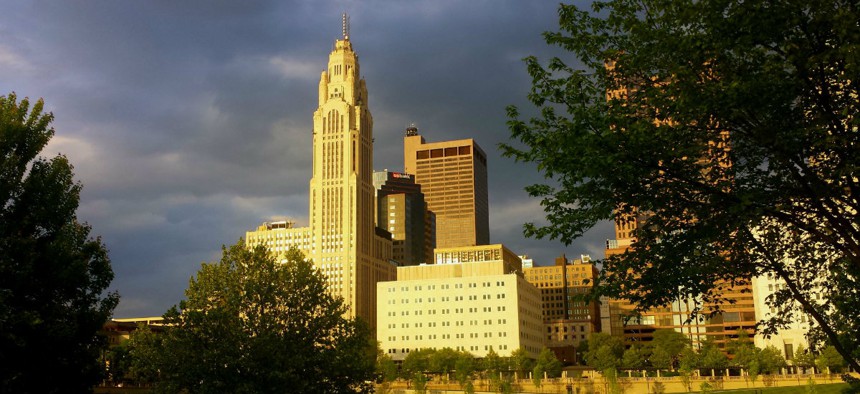Columbus ‘Put Forward an Impressive, Holistic Vision’ for Its Winning Smart City Plan

Columbus, Ohio. Michael Grass
“They were able to connect the problems they identified to specific technology solutions that are measurable,” said Transportation Secretary Anthony Foxx.
Clear and comprehensive proposals, for how technology like self-driving vehicles and data analytics can be used to address problems ranging from infant mortality to traffic congestion, helped Columbus, Ohio, edge out six other finalists in a contest for up to $50 million in funding for advanced street and transit projects, according to Transportation Secretary Anthony Foxx.
Foxx and other officials formally declared Thursday that Ohio’s capital had come out on top in the so-called Smart City Challenge—though news of the city’s win first surfaced earlier this week. The grant program is meant to spur urban transportation innovations. As the winner, Columbus is expected to act as a testbed, demonstrating how technology like autonomous vehicles, and sensor-equipped infrastructure might be deployed elsewhere.
“This is a game changer for Columbus,” Mayor Andrew Ginther said during a conference call with reporters Thursday. “We've put forth an aggressive, forward thinking and realistic program that we think is transferrable to cities around the world.”
Columbus beat out six other finalist cities: Austin, Texas; Denver; Kansas City, Missouri; Pittsburgh; Portland, Oregon; and San Francisco. The finalists were selected from a group of 78 cities that initially applied for the challenge after it launched last year.
Through its Smart City Challenge plans, Columbus is aiming to tackle problems related to public health, population growth and traffic.
Among the aspects of the city’s application Foxx highlighted during the Thursday call was a plan for three self-driving, electric shuttles that would link a new bus rapid transit center to a retail district, with the intent of creating better transportation connections to jobs.
He also noted the city’s proposals to use data analytics in an effort to help improve access to healthcare—particularly pre-natal care—for lower income residents.
Expanded investments in electric vehicle charging stations, and sensor technology designed to improve safety and the flow of traffic and freight through the city, are other examples of initiatives Columbus plans to undertake using the funding it is now set to receive.
Route Fifty recently profiled the city’s Smart City Challenge bid as part of a special series on all seven finalist cities.
“Columbus was selected as the winner because they put forward an impressive, holistic vision for how technology can help all of its residents move better and access opportunity,” Foxx said.
He added: “I think the thing that distinguished Columbus was that they were able to connect the problems they identified to specific technology solutions that are measurable.”
As much as $40 million in federal funding will now become available to Columbus through the Smart City Challenge program. That money, however, is contingent on appropriations. The city will also be eligible for up to $10 million from Seattle-based Vulcan Inc., an investment firm started by Microsoft co-founder Paul G. Allen.
Using the program as leverage, Columbus also lined up an additional $90 million in investments. Much of that support is coming from private sector partners.
“The creativity of their proposal and the partnerships that Columbus put together are remarkable,” said Barbara Bennett, president and chief operating officer of Vulcan. During Thursday’s call, she pointed out that more than 50 of the city’s CEOs had personally committed to purchasing and driving electric vehicles, and to installing charging stations for employees.
Columbus has been a leader in the Midwest in terms of population growth, jobs and technology startups, according to Ginther. The city’s population went up to about 850,000 in 2015, from around 788,000 in 2010, U.S. Census Bureau estimates show.
But the mayor noted deep problems in Columbus’ Linden neighborhood. Unemployment there is nearly three-times higher, and incarceration rates over six-times higher, compared to other parts of the city. And infant mortality rates in the neighborhood far outpace the national average.
Ginther explained that a flagship component of the city’s Smart City Challenge plan involves investments and technology deployments targeting Linden.
Using transportation technology to narrow economic divides and address issues tied to equity was a cardinal theme throughout the Smart City Challenge.
The U.S. Department of Transportation has said it will continue to work with the other six finalist cities to help them achieve goals outlined in their applications.
“This was a stiff competition and frankly, you know, no shade being thrown on Columbus, there were many cities that were as competitive,” Foxx said. “One of the things that we found through this challenge is that there is no one way to have a smart city,” the transportation secretary added. “It really depends on the unique mobility challenges that each city faces.”
Bill Lucia is a Reporter for Government Executive’s Route Fifty and is based in Washington, D.C.
NEXT STORY: Columbus Tops 6 Other Finalists to Win USDOT’s ‘Smart City Challenge’






